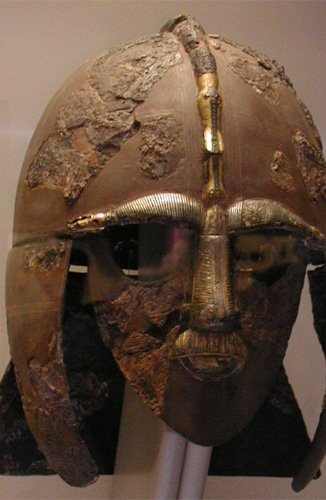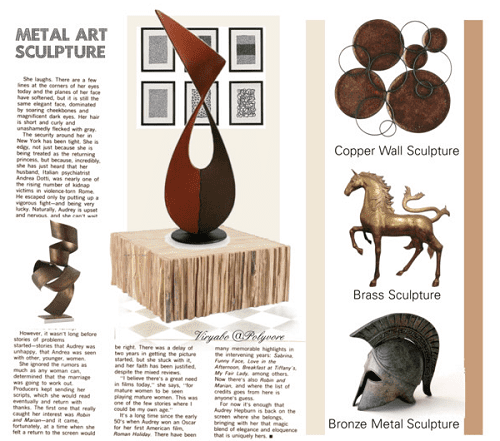The Incas Used What Material to Help Harden the Metals They Used in Their Art
Metallic art is greatly valued for its craftsmanship and designs, thus spurring my interest in an art that has tremendous decorative value.
Metal art often just considered as metal wall art covers many spheres of both functional and purely decorative artwork. Functional similar metal clocks, cutlery, and sleek appliances, and decorative like picture-prints on metallic sheets, statuary sculptures, exquisite chess pieces, and décor accents.
From wire metal filigree works and cast metal sculptures made from bronze, to ancient hammered metal cups and fine gold Egyptian jewellry, the resilience of earth metals and their malleable nature has made them one of the best materials to brand cute works of art and crafts.

Many treasures and artefacts that survived the pyramids of Egypt are variations of metal artworks. They include statues, ornaments, golden coins and funeral masks. The magnificent statues still standing today in Greece and Rome were cast in bronze. The people of ancient American civilizations (the Incas, Mayans, and Aztecs) fabricated hatchets and ceremonial implements from hammered copper. Objects of the religion like crucifixes and sacred fine art were as well crafted to exquisite perfection by monks in their monastery. And the spectacular Statue of Freedom in New York Harbour is a metalwork of fine art made from copper and wrought atomic number 26.
Now, there is a renewed interest in metal artworks, particularly for use as decoration and adornment purposes. Jewellers, just like in the days of old, make beautiful crafts from precious metals enhanced with precious or simulated stones or enamel motifs. And designers, and decorators at present, more than ever, utilize metal products as wall art, sculptures, statues, furniture, decorative hardware and ironmongery, and ornamental staircase railings.
1. Iron Ore
Of all the known metals, atomic number 26 is the most abundant of all and can exist found in almost all elements; water, soil, and rocks.
It is known to be a prized material from ancient times and iron objects take been discovered in Nineveh, Egypt, Roman Uk and ancient Prc.
This metal isn't exactly pure because it contains some silicon, sulfur, carbon, and phosphorus, with the three chief varieties of commercial iron . . . cast iron (pig iron), wrought atomic number 26, and steel containing various degrees of carbon compounds.
All artwork and sculptures, including other iron objects, are probable to rust when they get exposed to damp air, moisture or h2o. However, because iron ore is prone to rust, it can be prevented when coated with non-oxidising materials like tin, brass or zinc.
Fe is made into personal adornments, manus tools, cooking pots, garden sculptures and drinking vessels, forth with ornamentation of weaponry, equus caballus-tacks, boats and other functional items.
The corporeality of carbon in bandage iron, wrought iron and steel is what determines their character, strength and working qualities. Wrought fe contains the least amount of carbon while cast iron contains the most.
From larger than life sculptures to irresistibly petite decorations and art forms, all the different types of atomic number 26 artwork are made from one of these three:

Metal Art
ivc.edu
- Cast fe – It contains a good corporeality of carbon which gives it a brittle quality. It cracks easily if striking difficult is extremely coarse, and cannot be stretched or aptitude. Cast fe isn't really used in the decorative arts because of its roughness but is mainly used for ornamental firebacks and facings, fireplace accessories and traditional stoves.
- Steel – Steel'south hardness is a mid-manner betwixt wrought and cast atomic number 26 so it possesses characteristics of both. It has a finer grade and is lighter and malleable if exposed to very high temperatures. With sudden cold temperatures, it becomes extremely difficult. Steel has a shine and though it is used majorly for structural works and reinforcement materials, information technology is too used for contemporary artwork and sculptures.
- Stainless steel - Alloying chromium with steel helps to foreclose information technology from rusting and retain its lustre and stainless steel is assimilated with x% to twenty% of chromium. Its lustre, non-rusting qualities, and its beauty make it suitable for exquisite cutlery, staircase railings, decorative hardware, and jewelry.
- Wrought Fe - Wrought iron has fewer carbon impurities than cast iron and is softer in nature. Information technology is hands rolled into plates, hammered into bars and drawn into wires. Its malleability allows it bend into any shape or form, Wrought iron items can exist painted with brass and various thicknesses of the iron can be used for cheaper hardware, braces and brackets, garden furniture, outdoor ornaments and garden sculptures, fireplace linings, railings and balustrades, grilles, and affordable light fittings.
2. Tin can
Tin is majorly used for metal wall artworks, plaques, figural sculptures, hanging ornaments, tin wall signs, busts, decorative badges, h2o vessels, ornate vases, candlesticks, and can foil fine art.
Tin in all forms have been used for recycled art with some of the most awesome metal art formed this way. Recyclable tin materials include bottle tops, sweet tins, nutrient cans, and the like.
Scroll to Go along
Read More From Owlcation
Ane of the least known but cute expressions of metal art are the tin artworks first produced in United mexican states around the 16th century.
Because tin was non merely available and cheap, it was light and malleable. This made it easy to shape, crimp, stamp, punch, and cut into a wide variety of decorative and functional artwork, and paint in pleasant colours.
Can's shiny surface that looks similar to silvery is what likely contributes to its appeal for making art objects and sculptures, regardless of its tendency to rust.
3. Copper
Copper is a metal that is constitute in its pure state, just as silver, gold and tin and pre-dates atomic number 26 in terms of its employ. According to the history of art, most nations used copper extensively as materials to brand coins, weapons, statues, décor, and household items.
Information technology is besides claimed that the aboriginal Egyptians used copper chisels hardened by a now unknown process to cut their granite.
This metal is used for both decorative and industrial arts and is favoured for its strength, durability, and its workability. The ease with which copper can exist molded (information technology tin exist hammered or bandage) into whatever desired shape or form makes it a useful and great metal to use for the post-obit:
- Hardware
- Sculpture works
- Wall art
- Statues
- Tabular array ornaments
- Vases and urns
- Display pedestals
- Lighting fixtures
- Screens
- Grilles
- Kitchen utensils
- Ethnic jewelry
- Clocks
Jewelers combine copper with silver or aureate to harden them for jewelry making. Copper is as well alloyed with nickel and zinc to make beautiful pieces of German language argent.
Because copper is very durable, it is used extensively for the production of small-scale ornamental objects and for structural objects that tin can't endure excessive strain.
Further Reading:
History of Decorative Metal Works
Nearly all the ancient civilizations used bronze in their art even as its discovery dates back to the time of the Sumerians around 3500 BC.
Harder than atomic number 26 with anti-corrosive qualities, it is the virtually popular metal for cast metallic sculptures and statues and was used mainly as Roman weapons of war in ancient times.
Bronze is strong and durable and can be cast with ease in the nigh intricate delicate patterns or imposing and magnificent forms, all in a not bad variety of colours, shapes, and styles. It is more popularly used than copper (and contumely) to create metal ornaments, sculptures, statues, figurines, plates, chalices, and unique hardware.
The surface finish of statuary works are obtained past dipping the finished object into a 'bathroom' of diverse types of acid but the finishing results are only light veneers and soon wear off if the object is knocked about, handled too frequently, or exposed to harsh weather conditions.
Bronze artworks include:
- Ancient Greece busts
- Figurines
- Religious vessels
- Sculptures
- Statues
- Metal plates
- Masks
- Awe-inspiring castings

Brass was discovered much later than statuary, effectually 500 BC, and is a vivid xanthous tinted metal that can be polished to a high shine and because it tarnishes easily, it requires a high level of polishing to keep it looking bright and lustrous.
Traditionally, metal craftsmen protected its shine with a coat of lacquer. Though this may accept prolonged its shine, information technology nonetheless didn't stop it from tarnishing.
Brass is soft and malleable and can be rolled into thin sheets afterward which designs can be etched, stamped, hammered out, and 'spun' while shapes and forms tin can be hands created.
It is also used as base materials for decorative metallic ornaments and jewelry that are thinly or thickly coated in silvery or gilded.
Contumely fine art and decorative items include:
- Article of clothing brass fine art
- Vintage brass motifs
- Jewelry
- Musical instruments
- Brass stampings
- Ornaments
- Antique padlocks
- Door knockers and other intricate and decorative ironmongery
- Retro hardware
- Brass statues and sculptures
- Furniture and furnishings hardware
There are a number of metal objects of fine art that are greatly valued for their craftsmanship and designs. They are not necessarily valuable metals but they possess great decorative value. These metals include antiquarian silverish, pewter, classic Sheffield plate, and lead.
© 2012 artsofthetimes
Sani Muhammad Babangida on Dec 21, 2019:
Metal sculptures are done for aesthetic purposes.
artsofthetimes (author) on Apr 23, 2019:
TheSevenElementsls, I will avoid using:
Aluminium,
Mercury (for obvious reasons),
Gallium,
and, Iridium.
TheSevenElementals on April 22, 2019:
What type of metal should be avoided while making a sculpture?
artsofthetimes (author) on December 27, 2018:
Rewati, I suggest you use statuary.
It is the about popularly used metal for metal sculptures. It is long lasting and does non crave every bit much cleaning and polishing as brass (another metal you can use).
Bronze sculptures are easily cleaned and shined with a soft dry textile. This translates to easy maintenance.
Rewati Prasad Rai on December 26, 2018:
I wish to make bust of my late begetter and mother. Kindly suggest what metal to be used so that it gives good outcome and it should last for long time.
artsofthetimes (author) on October 09, 2018:
You are welcome.
RTalloni on October 08, 2018:
Thanks for this look at metal arts.
tarang on Apr 28, 2018:
Bronze is the most popular metal for casting statuary sculptures and figurines. It is an alloy of copper with tin can and other metals or not-metallic and metalloids. Bronze has an unusual property of expanding slightly before regaining a shape and it tends to shrink a little once cooled downwardly, thus it is beingness used for many generations for sculpture making. Statuary alloy strength and ductility it's been a favorite choice of metal to cast Sculptures in action.world wide web.tarangarts.com
Source: https://owlcation.com/humanities/metal-art-decorative-uses-of-iron-tin-lead
0 Response to "The Incas Used What Material to Help Harden the Metals They Used in Their Art"
Publicar un comentario